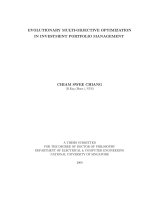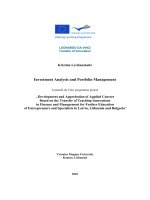Investment portfolio management exam 2013 questions
Bạn đang xem bản rút gọn của tài liệu. Xem và tải ngay bản đầy đủ của tài liệu tại đây (441.92 KB, 14 trang )
lOMoARcPSD|1142237
Exam 2013, questions
Investments and Portfolio Management (Monash University)
Distributing prohibited | Downloaded by ??ng Giang ()
lOMoARcPSD|1142237
OFFICE USE ONLY
Monash University
Semester Two Examination 2013
Faculty of Business and Economics
Department of Accounting and Finance
EXAM CODES:
AFW3121
TITLE OF PAPER:
INVESTMENTS AND PORTFOLIO MANAGEMENT
EXAM DURATION:
3 hours
READING TIME:
10 minutes
THIS PAPER IS FOR STUDENTS STUDYING AT: (officefusefonlyf-ftickfwherefspplicsble)f
Berwick
Clayton
Peninsula
Distance Education
Caulfield
Gippsland
Sunway
Open Learning
Other (specify)
During an exam, you must not have in your possession, a book, notes, paper, calculator, pencil case,
mobile phone or any other material/item which has not been authorised for the exam or specifically
permitted as noted below. Any material or item on your desk, chair or person will be deemed to be in
your possession. You are reminded that possession of unauthorised materials in an exam is a
disciplinable offence under Monash Statute 4.1.
AUTHORISED MATERIALS
CALCULATORS
YES
NO
(If YES, only calculators with an 'approved for use' Faculty label are permitted)
OPEN BOOK
YES
NO
SPECIFICALLY PERMITTED ITEMS
if yes, items permitted are:
YES
NO
This paper consists of ten (10) questions, four (4) pages of formulae and
one (1) page of tables printed on a total of thirteen (13) pages.
Students must attempt to answer ALL questions.
STUDENT ID: …………………………...
DESK NUMBER: …………………….
PLEASE CHECK THE PAPER BEFORE COMMENCING. THIS IS A FINAL PAPER. THIS EXAMINATION
PAPER MUST BE INSERTED INTO THE ANSWER BOOK AT THE COMPLETION OF THE PAPER.
NO EXAMINATION PAPERS SHOULD BE REMOVED FROM THE EXAMINATION ROOM
AFW3121 Dr Abey Gunasekarage
Distributing prohibited | Downloaded by ??ng Giang ()
Page 1 of 13
lOMoARcPSD|1142237
OFFICE USE ONLY
AFW3121 INVESTMENTS AND PORTFOLIO MANAGEMENT
Question 1: Financial Instruments & Markets
(a)
(b)
Discuss the advantages and disadvantages of common stock ownership, relative to
other investment alternatives.
(2 marks)
The following is a price quotation for a U.S Treasury Bond:
Maturity
Coupon rate
Bid
Ask
May 15 39
4.250
98:25
98:30
(i)
How much would you have to pay to purchase one of these bonds?
(ii)
How much is the annual coupon amount (in $)?
(iii) Calculate the current yield of the bond.
(2 + 2 + 2 = 6 marks)
(c)
Why are mortgage backed securities called pass throughs?
(2 marks)
[TOTAL = 10 MARKS]
Question 2: Trading Mechanism; Mutual Funds & Investment Companies
(a)
Describe margin buying of common stocks. What are the advantages and
disadvantages of buying stocks on margin?
(2 marks)
(b)
Nikita opens a brokerage account and purchases 200 shares of AAA Ltd at $50 per
share. She borrows $4,000 from her broker at an interest rate of 8% p.a. to pay for the
transaction.
(i)
Calculate the margin in Nikita’s account at the time of purchasing the shares.
(ii)
If the share price falls to $40 per share by the end of the year, calculate the
remaining margin in her account.
(iii) What is the rate of return on her investment?
(2 + 2 + 2 = 6 marks)
(c)
Differentiate between an open end fund and a closed end fund.
(2 marks)
[TOTAL = 10 MARKS]
AFW3121 Dr Abey Gunasekarage
Distributing prohibited | Downloaded by ??ng Giang ()
Page 2 of 13
lOMoARcPSD|1142237
OFFICE USE ONLY
AFW3121 INVESTMENTS AND PORTFOLIO MANAGEMENT
Question 3: Risk & Return; Risk Aversion & Capital Allocation
(a)
Over the past year you earned a nominal rate of interest of 3.6 percent on your
money. The inflation rate was 3.1 percent over the same period. Calculate the exact
real growth rate of your purchasing power.
(2 marks)
(b)
Calculate the Holding Period Return for each of the following investments:
(c)
(i)
You purchased a share of stock for $65. One year later you received a dividend of
$2.37 and sold the share for $63.
(ii)
An investor purchased a bond 63 days ago for $980. He received a coupon
payment of $17 and sold the bond for $987.
(2 + 2 = 4 marks)
You are considering investing $1,000 in a T-bill that pays 5% and in a risky portfolio,
P. The risky portfolio (P) is constructed with 2 risky securities, X and Y. The weights of
X and Y in P are 0.60 and 0.40 respectively. X has an expected rate of return of 14%
and variance of 10%, and Y has an expected rate of return of 1% and a variance of 3%.
If you want to form a complete portfolio with an expected rate of return of 10%, what
percentages of your money must you invest in the T-bill, X, and Y, respectively.
(4 marks)
[TOTAL = 10 MARKS]
AFW3121 Dr Abey Gunasekarage
Distributing prohibited | Downloaded by ??ng Giang ()
Page 3 of 13
lOMoARcPSD|1142237
OFFICE USE ONLY
AFW3121 INVESTMENTS AND PORTFOLIO MANAGEMENT
Question 4: Optimal Risky Portfolios; Index Models
(a)
(b)
Consider two perfectly negatively correlated risky securities A and B. A has an
expected rate of return of 10% and a standard deviation of 16%. B has an expected
rate of return of 8% and a standard deviation of 12%.
Calculate the following:
(i)
The weights of A and B in the global minimum variance (perfectly hedged)
portfolio.
(ii)
The expected rate of return of the above risk-free portfolio that can be formed
with these two assets.
(2 + 2 = 4 marks)
The index model has been estimated for stocks A and B with the following results:
RA= 0.01 + 0.5RM+ eA
RB= 0.02 + 1.3RM+ eB
σM= 0.25
σ(eA) = 0.20
σ(eB) = 0.10
(i)
Calculate the covariance between the returns on stocks A and B.
(ii)
Calculate the standard deviation of each individual stock.
(2 + 4 = 6 marks)
[TOTAL = 10 MARKS]
AFW3121 Dr Abey Gunasekarage
Distributing prohibited | Downloaded by ??ng Giang ()
Page 4 of 13
lOMoARcPSD|1142237
OFFICE USE ONLY
AFW3121 INVESTMENTS AND PORTFOLIO MANAGEMENT
Question 5: CAPM
(a)
Explain the terms Capital Market Line and Security Market Line using relevant graphs.
(4 marks)
(b)
Assume that the risk-free rate is 7% and the expected market rate of return is 15% for
an economy.
(i)
Draw the Security market line (SML) and plot the risk-free asset and market
portfolio on it.
(1 mark)
(ii)
Stocks A & B have the following actual returns and beta values:
Actual Return
Beta (β)
Stock A
12.0%
1.3
Stock B
13.4%
0.8
Plot A & B on the above security market line and state whether they are
undervalued, overvalued or fairly priced. Also state the appropriate investment
strategy, i.e. whether to sell, purchase or hold each security.
(4 marks)
(iii) Calculate the Alpha (α) value for each of the securities.
(1 mark)
[TOTAL = 10 MARKS]
AFW3121 Dr Abey Gunasekarage
Distributing prohibited | Downloaded by ??ng Giang ()
Page 5 of 13
lOMoARcPSD|1142237
OFFICE USE ONLY
AFW3121 INVESTMENTS AND PORTFOLIO MANAGEMENT
Question 6: Market Efficiency & Behavioural Finance
(a)
(b)
(c)
Define weak-form, semi-strong form and strong form market efficiencies.
(3 marks)
Explain how technicians use resistance and support levels of stock prices to
implement investment strategies.
(3 marks)
Identify each of the following behavioural characteristics.
(i)
People who make decisions that turn out badly blame themselves more when
that decision was unconventional.
(ii)
A person may reject an investment when it is posed in terms of risk surrounding
potential gains but may accept the same investment if it is posed in terms of risk
surrounding potential losses.
(iii) Some investors’ irrational preference for stocks with high cash dividends and
their tendency to hold onto losing positions for too long.
(iv) It is not as painful to have purchased a blue-chip stock that decreases in value, as
it is to lose money on an unknown start-up firm.
(1 + 1 + 1 + 1 = 4 marks)
[TOTAL = 10 MARKS]
Question 7: Bond Prices & Yields; Bond Portfolio Management
(a)
You purchased an annual interest coupon bond one year ago. At the time of purchase,
the bond had 9 years remaining to maturity. The coupon rate of the bond is 10% and
the par value is $1,000. At the time you purchased the bond, the yield to maturity was
8%.
You sold the bond after receiving the first interest payment. At the time of sale, the
yield to maturity was 7%. If you pay 40% tax on your coupon income and 25% tax on
your capital gain income, calculate your after tax annual rate of return on this
investment.
(5 marks)
(b)
An 8% coupon bond with a face value of $1,000 has a maturity of four years. Its yield
to maturity is 10%. Assume that the coupons are paid annually.
(i)
What is the modified duration of this bond?
(ii)
If the market yield decreases by 25 basis points, what will be the new price of
the bond?
(3.5 + 1.5 = 5 marks)
[TOTAL = 10 marks]
AFW3121 Dr Abey Gunasekarage
Distributing prohibited | Downloaded by ??ng Giang ()
Page 6 of 13
lOMoARcPSD|1142237
OFFICE USE ONLY
AFW3121 INVESTMENTS AND PORTFOLIO MANAGEMENT
Question 8: Equity Valuation
(a)
J.C. Penney Company reported earnings per share of $4.20 last year and paid a
dividend per share of $1.20. It is expected to pay a dividend in year 1 of $1.65, a
dividend in year 2 of $1.97, and a dividend in year 3 of $2.54. After year 3, dividends
are expected to grow at a constant rate of 8% per year.
The expected risk free rate is 5% and the expected return on the market portfolio is
15%. J.C. Penney Company has a beta of 0.60.
(i)
What is the intrinsic value of J.C. Penney Company’s stock today?
(ii)
(b)
What is the present value of growth opportunities of J.C. Penney Company’s
stock?
(5 + 2 = 7 marks)
What are the pitfalls of P/E analysis in valuing stocks?
(3 marks)
[TOTAL = 10 MARKS]
Question 9: Options Markets; Option Valuation
(a)
Premiums on a call option and a put option with a strike price of $120 are $ 7.75 and
$0.26 respectively. Assuming that the stock price on the expiry date is $125, calculate
the pay-off and the profit on each of these two options.
(3 marks)
(b)
A call option with an exercise price of $100 has a 1 year to expiration. The underlying
stock of this option has a current price of $100. You believe that there is a 50% chance
of stock price increasing to $120 and a 50% chance of stock price decreasing to $80 in
one year. The risk free rate of interest is 10%.
Calculate the value of this option using the binomial option pricing approach.
(7 marks)
[TOTAL = 10 marks]
AFW3121 Dr Abey Gunasekarage
Distributing prohibited | Downloaded by ??ng Giang ()
Page 7 of 13
lOMoARcPSD|1142237
OFFICE USE ONLY
AFW3121 INVESTMENTS AND PORTFOLIO MANAGEMENT
Question 10: Portfolio Performance Evaluation; International Diversification
(a)
In a particular year, Razorback Mutual Fund earned a return of 1% by making the
following investments in asset classes:
Weight
Return
Bonds
20%
5%
Stocks
80%
0%
The return on a benchmark portfolio was 2%, calculated from the following
information:
Weight
Return
Bonds (Lehman Brothers Index)
50%
5%
Stocks (S&P 500 Index)
50%
-1%
Calculate the following:
(i)
The total excess return on the Razorback Fund's managed portfolio.
(ii)
The contribution of asset allocation across markets to the Razorback Fund's
total excess return.
(iii) The contribution of security selection within markets to the Razorback Fund's
total excess return.
(2 + 2 + 2 = 6 marks)
(b)
Discuss the performance evaluation of international portfolio managers in terms of
potential sources of abnormal returns.
(4 marks)
[TOTAL = 10 MARKS]
END OF EXAMINATION
AFW3121 Dr Abey Gunasekarage
Distributing prohibited | Downloaded by ??ng Giang ()
Page 8 of 13
lOMoARcPSD|1142237
OFFICE USE ONLY
AFW3121 INVESTMENTS AND PORTFOLIO MANAGEMENT
Formulae
(1+R) = (1+r) (1+i)
R(1 − t) − i = (r + i)(1 − t ) − i = r(1 − t) − it
NAV =
Market Value of Assets − Liabilities
Shares Outs tan ding
(1 + EAR ) = [1 + R f (T )] T
1
r=
P1 − P0 + D1
P0
E (rP ) − r f
σ C
E (rC ) = r f +
σP
E ( rC ) = r f + y [E ( rP ) − r f ]
S=
E ( rP ) − rf
σP
Cov( Ri , R j ) = β i × β j × σ M2
σ C = y ×σ P
W1 =
σ 22 − Cov(r1 , r2 )
σ 12 + σ 22 − 2Cov(r1 , r2 )
σ P2 = (W12 )(σ 12 ) + (W22 )(σ 22 ) + 2(W1 )(W2 )Cov(r1 , r2 )
Cov ( r1, r2 ) = ρ1, 2 × σ 1 × σ 2
E ( ri ) = r f + β i [ E ( rm ) − r f ]
E (r ) =
s=n
∑p
s =1
σ
2
=
s=n
∑
s =1
s
× rs
2
( p s ) × [r s − E ( r s ) ]
AFW3121 Dr Abey Gunasekarage
Distributing prohibited | Downloaded by ??ng Giang ()
Page 9 of 13
lOMoARcPSD|1142237
OFFICE USE ONLY
AFW3121 INVESTMENTS AND PORTFOLIO MANAGEMENT
U = E ( r ) − 0.5( A)(σ 2 )
i =n
E ( rP ) = ∑ Wi × E (ri )
i =1
σ (eP ) = wA2 × σ 2 (eA ) + wB2 × σ 2 (eB ) + w2f × σ 2 (e f )
2
β 2 × σ m2
σ i2
Ri ,t = α i + β i R M ,t + e i , t
R2 =
σ i2 = β 2σ m2 + σ 2 (ei )
σ P2 = β P2σ M2 + σ 2 (e p )
n
β P = ∑ Wi × β i
i =1
WD =
y* =
σE
σ D +σ E
E(rP ) −rf
A(σP2 )
T
T
PB = ∑ Ct T + ParValue
T
(1+ r )
t =1 (1+ r )
Po =
Do(1 + g )
k−g
g = ROE × b
D =
T
∑ t ×w
t
t =1
[
]
t
wt = CF t (1 + y ) Price
P
0
=
D + D
(1+ k ) (1+ k )
1
2
1
2
... +
D +P
(1+ k )
N
N
N
∆P
∆ (1 + y )
= −D ×
P
(1 + y )
AFW3121 Dr Abey Gunasekarage
Distributing prohibited | Downloaded by ??ng Giang ()
Page 10 of 13
lOMoARcPSD|1142237
OFFICE USE ONLY
AFW3121 INVESTMENTS AND PORTFOLIO MANAGEMENT
D* =
D=
D
(1 + y )
1 + y (1 + y ) + T (c − y )
−
y
c[(1 + y )T − 1] + y
E1
+ PVGO
k
P0 1
=
E1 k
P0 =
∆P
= − D * × ∆y
P
D1
E1(1 − b)
=
k − g k − (b × ROE )
P0
1− b
=
E1 k − (b × ROE )
P0 =
∆P
= − D * (∆y ) + 1 (Convexity)(∆y) 2
2
P
Po =
D
k
∞
Po = ∑
t =1
H =
Dt
(1 + k ) t
Cu − Cd
uS 0 − dS 0
σ2
S
T
ln 0 + r +
2
X
d1 =
σ× T
d 2 = d1 − σ × T
AFW3121 Dr Abey Gunasekarage
Distributing prohibited | Downloaded by ??ng Giang ()
Page 11 of 13
lOMoARcPSD|1142237
OFFICE USE ONLY
AFW3121 INVESTMENTS AND PORTFOLIO MANAGEMENT
C 0 = S 0 × N ( d1 ) − Xe − rT × N (d 2 )
X
C − P = S0 −
(1 + r f ) T
(1 + rG ) n = (1 + r1 )(1 + r2 )...(1 + rn )
Cn
C1
C2
PV =
+
+ ...
1
2
(1 + r ) (1 + r )
(1 + r )n
? =
?=
?=
r
−r
p
σ
f
P
rp −rf
βP
αP
σ (e P )
[
]
αP = r P − r f + βP (r m − r f )
n
n
i =1
i =1
rp − rB = ∑wpi × rpi − ∑wBi × rBi
ARi ,t = Ri ,t − [ R f ,t + β i ( Rm ,t − R f ,t )]
? = (WPi − WBi )rBi
? = (rPi − rBi )WPi
ARi ,t = Ri ,t − [α i + β i ( Rm ,t )]
AFW3121 Dr Abey Gunasekarage
Distributing prohibited | Downloaded by ??ng Giang ()
Page 12 of 13
lOMoARcPSD|1142237
OFFICE USE ONLY
AFW3121 INVESTMENTS AND PORTFOLIO MANAGEMENT
AFW3121 Dr Abey Gunasekarage
Distributing prohibited | Downloaded by ??ng Giang ()
Page 13 of 13









